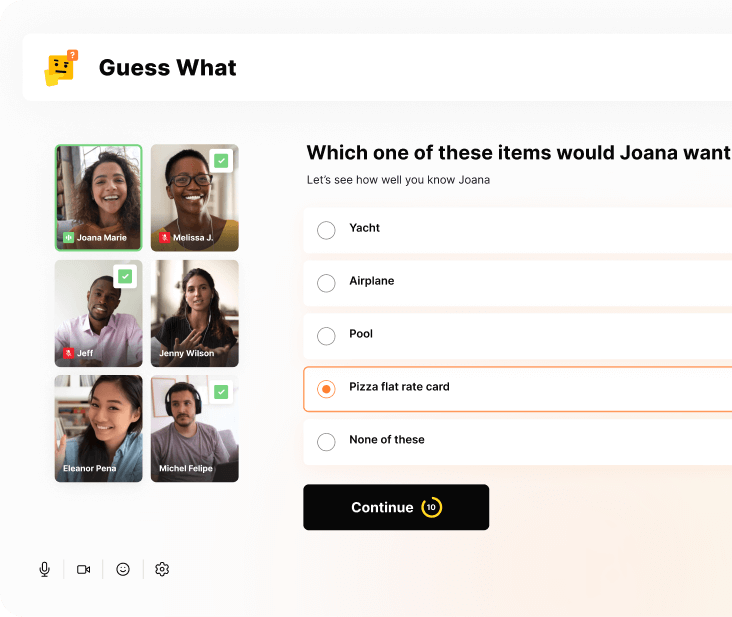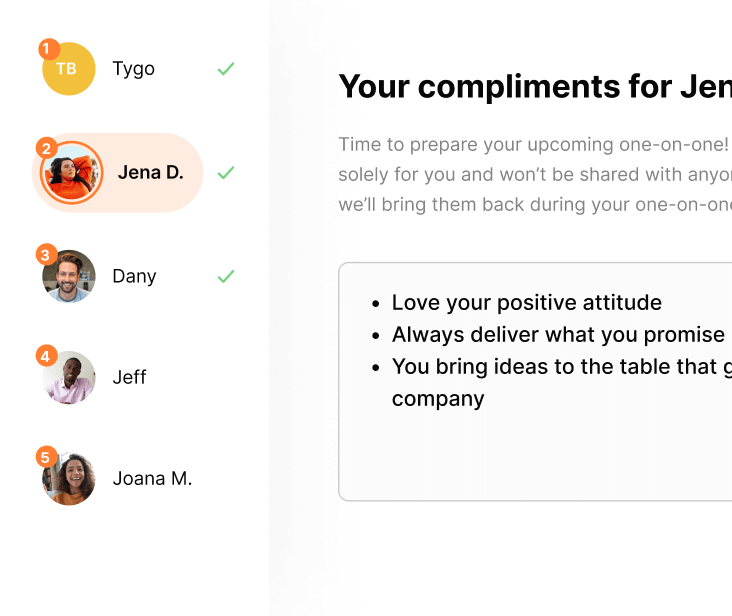Back to Blog
Employee satisfaction surveys: 6 benefits you NEED to consider
Ah, it’s that time of year again. Employee satisfaction surveys are in our inboxes!
But hold up. Why are we doing this again? Does anyone even care?
The answer is a capital Y-E-S. Although satisfaction surveys have been abused, ignored, and ridiculed, they have their place - if done with the intention of actually improving employee satisfaction.
Let’s look at how employers and employees benefit from employee satisfaction surveys.
More from our series on employee satisfaction:
- The absolute best employee engagement apps
- Employee engagement statistics you’ll WANT to know
- Team building activities for work
- Free team building activities that don’t suck
Benefits for the company:
You may be here because your boss said, “Satisfaction surveys? Why would we do that?”.
Here’s what to tell them.
1. Better talent retention and lower replacement costs
When employees are happy at work, they’re less likely to look for another job. It’s as simple as that. Satisfaction surveys allow companies to understand how happy employees are, where the biggest areas for improvement are, and set goals for the future.
In short, the survey will help companies make employees happier, retain talent, and spend fewer resources on hiring new talent. You’ll also be able to make satisfaction a measurable goal for your leadership team.
2. Attract the best talent
When employees do leave or your company is expanding, you’ll want to hire the best person for the job (we hope).
One of the first things potential applicants will do before applying is to
- study your careers page on your website and
- take a close look at reviews on Glassdoor, Indeed, or Kununu.
You can proudly share employee satisfaction on your careers page if employee satisfaction is high. You’ll also receive higher reviews from your employees. Both will help you attract the best candidates.
Of course, surveys alone won’t increase your employee satisfaction. But they show you the path to improving.
3. Higher performance
Satisfied employees do their best work. Sound like a thing every blog on the internet writes? Science has our backs, though:
- Saarce Elsye Hatane: Employee satisfaction and performance
- Abdulwahab S. Bin Shmailan: The relationship between job satisfaction, job performance, and employee engagement
After your employee satisfaction survey, you’ll know what to do to provide a workplace that drives employees’ performance to new heights.
Related: Team building activities for high-performance teams.
Share fun facts and bond with a team quiz
Have your participants choose from a list of questions they’d like their coworkers to answer about them, before watching as they guess the right answer.
01. Yes
share-fun-facts-and-bond-with-a-team-quiz

Run a guided recognition activity
Have your participants choose from a list of questions they’d like their coworkers to answer about them, before watching as they guess the right answer.
01. Yes
run-a-guided-recognition-activity

Organize a virtual cooking class
Hire a professional chef to help your team cook a delicious lunch or dinner. May be difficult for co-workers with families. To find providers and get tips, read our blog about virtual cooking classes.
02. No
organize-a-virtual-cooking-class

Hire a stand-up comedian
Have your participants choose from a list of questions they’d like their coworkers to answer about them, before watching as they guess the right answer.
02. No
hire-a-stand-up-comedian

No items found
No items found
Table of contents
Ah, it’s that time of year again. Employee satisfaction surveys are in our inboxes!
But hold up. Why are we doing this again? Does anyone even care?
The answer is a capital Y-E-S. Although satisfaction surveys have been abused, ignored, and ridiculed, they have their place - if done with the intention of actually improving employee satisfaction.
Let’s look at how employers and employees benefit from employee satisfaction surveys.
More from our series on employee satisfaction:
- The absolute best employee engagement apps
- Employee engagement statistics you’ll WANT to know
- Team building activities for work
- Free team building activities that don’t suck
Benefits for the company:
You may be here because your boss said, “Satisfaction surveys? Why would we do that?”.
Here’s what to tell them.
1. Better talent retention and lower replacement costs
When employees are happy at work, they’re less likely to look for another job. It’s as simple as that. Satisfaction surveys allow companies to understand how happy employees are, where the biggest areas for improvement are, and set goals for the future.
In short, the survey will help companies make employees happier, retain talent, and spend fewer resources on hiring new talent. You’ll also be able to make satisfaction a measurable goal for your leadership team.
2. Attract the best talent
When employees do leave or your company is expanding, you’ll want to hire the best person for the job (we hope).
One of the first things potential applicants will do before applying is to
- study your careers page on your website and
- take a close look at reviews on Glassdoor, Indeed, or Kununu.
You can proudly share employee satisfaction on your careers page if employee satisfaction is high. You’ll also receive higher reviews from your employees. Both will help you attract the best candidates.
Of course, surveys alone won’t increase your employee satisfaction. But they show you the path to improving.
3. Higher performance
Satisfied employees do their best work. Sound like a thing every blog on the internet writes? Science has our backs, though:
- Saarce Elsye Hatane: Employee satisfaction and performance
- Abdulwahab S. Bin Shmailan: The relationship between job satisfaction, job performance, and employee engagement
After your employee satisfaction survey, you’ll know what to do to provide a workplace that drives employees’ performance to new heights.
Related: Team building activities for high-performance teams.
Benefits for employees
If you’re considering satisfaction surveys, look beyond your company’s benefits. There’s much to be gained for your employees, creating a win-win situation for the company.
1. A better workplace
Satisfaction surveys should give employees the chance to tell leadership what
- they love and want more of,
- what isn’t working for them and needs to change,
- and what’s missing that would improve their ability to do excellent work
The benefit for employees is nothing short of an excellent workplace shaped around their preferences and the happiness that results from working there.
2. Feel valued and heard
As we describe in our article on recognition and employee engagement, feeling valued is a critical piece of any relationship. Including the company-employee relationship.
Satisfaction surveys, if conducted with the intention to improve things, make employees feel precisely that: valued. The survey shows employees their opinion matters and invites them to shape their workplace.
Related: Using virtual employee engagement platforms to boost satisfaction.
3. Job stability
Just as companies benefit from low turnover, so do employees. Sure, job-hopping will increase your salary and, in some instances, accelerate your career. But it also introduces instability to your life:
- Will you like your new manager and coworkers?
- Is the new role the right fit for you?
- What’s the financial situation of the company?
- Will you have to hustle to prove your value early on?
Satisfaction surveys aren’t your golden ticket to the stability train. But they allow employees to shape their company in a way that might have them staying longer than they thought.
Why are employee satisfaction surveys important?
Let’s recap why employee satisfaction surveys are essential:
- They can increase talent retention and lower replacement costs
- They’ll help you attract the best talent and spur performance
- They allow employees to shape their workplace, increase recognition, and bring job stability
Granted, that’s a very high bar for getting started with satisfaction surveys.
Don’t overthink it - use a simple questionnaire and tools like Typeform or SurveyMonkey to get started.
Objectives of employee satisfaction surveys
The objectives for employee satisfaction surveys depend on your circumstances but may include things like
- Providing a great place to work for your employees
- Attracting the best talent in the industry
- Reducing turnover and hiring costs.
If you’ve been asked to conduct a survey and aren’t sure what the objective is, have a chat with whoever wants the survey to understand what they’re hoping to gain. You can list the benefits we described in this article as a starting point for your conversation.
Conducting employee satisfaction surveys
To make the most of an employee satisfaction survey,
- Get clear on your survey requirements
- Consider length
- Create the questionnaire
- Send it out
- Analyze the data
For in-depth guidance about these steps, read our guide on employee satisfaction surveys. Also, consider implementing solutions for increasing employee engagement, which are directly related to employee satisfaction.
Subscribe to get our latest updates
Subscribe to get our latest updates






